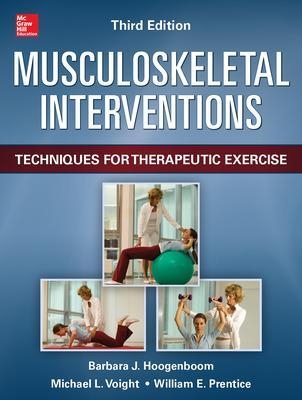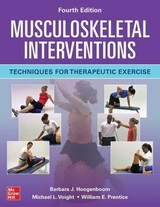
Musculoskeletal Interventions 3/E
McGraw-Hill Medical (Verlag)
978-0-07-179369-8 (ISBN)
- Titel ist leider vergriffen;
keine Neuauflage - Artikel merken
Publisher's Note: Products purchased from Third Party sellers are not guaranteed by the publisher for quality, authenticity, or access to any online entitlements included with the product.
The definitive guide to designing and implementing evidence-based rehabilitation programs using therapeutic exercise -- updated in full colorA Doody's Core Title for 2015!
Musculoskeletal Interventions, 3rd Edition, is a comprehensive guide to the system considerations, design, implementation, and progression of rehabilitation programs for musculoskeletal injuries and dysfunction. Encompassing many aspects of musculoskeletal rehabilitation, with contributions from many renowned authors, it focuses on the practical application of theory in a clinical setting, making it valuable to both students and experienced physical therapists. Musculoskeletal Interventions features an easy-to-follow body region and functional approach to intervention strategies and is logically divided into five sections:
Foundations of the Rehabilitation Process
Addresses the important considerations in designing a rehabilitation program for the patient with a musculoskeletal injury
Provides a guide-based overview of the rehabilitation process as well as an introduction to Clinical Reasoning and Algorithmic Thinking in rehabilitation
Treating Physiologic Impairments During Rehabilitation
Presents information on various physical impairments that may need to be addressed as part of the rehabilitation process
The Tools of Rehabilitation
Provides an overview of important rehabilitation tools and strategies
Delivers detailed coverage of how these interventions should be incorporated into a rehabilitation program to achieve the individualized treatment goals for patients with musculoskeletal pathologies
Intervention Strategies for Specific Injuries
Covers specific rehabilitation techniques and interventions applied to the treatment of a wide variety of regional musculoskeletal injuries, dysfunctions, and post-operative conditions
Special Consideration for Specific Patient Populations
Discusses treatment considerations for specific patient populations, such as the geriatric patient, pediatric patient, and physically active female
This edition is enhanced by a new full-color presentation, as well as the inclusion of valuablelearning aids, such as clinical pearls, protocol grids, algorithms, learning objectives at the beginning of eachchapter, and end-of-chapter treatment guidelines and references.
McGraw-Hill authors represent the leading experts in their fields and are dedicated to improving the lives, careers, and interests of readers worldwide McGraw-Hill authors represent the leading experts in their fields and are dedicated to improving the lives, careers, and interests of readers worldwide Dr. William Prentice is Professor of Exercise and Sport Science and Coordinator of the Sports Medicine Program at the University of North Carolina at Chapel Hill, where he also serves as the Director of the NATA approved Graduate Athletic Training Education Program. He received his BS and MS from the University of Delaware and his Ph.D. in Sports Medicine and Applied Physiology from the University of Virginia. He also has a BS in Physical Therapy from the University of North Carolina. He is a Certified Member of the National Athletic Trainers' Association and has received the Sayers A. "Bud" Miller Distinguished Athletic Trainer Educator Award and the Most Distinguished Athletic Trainer Award from the NATA. In 2004 he was inducted into the NATA Hall of Fame. Dr. Prentice served as the Athletic Trainer for the Women's Soccer Program, which has won eighteen NCAA National Championships. He teaches graduate courses in sports medicine and athletic training. Dr. Prentice is the author of nine best-selling texts in athletic training, sports medicine, and health-related fitness.
Part I: Foundations of theRehabilitation Process
Chapter 1: Introduction to theRehabilitation Process: The Guide toPhysical Therapist Practice
Chapter 2: Clinical Decision Making inRehabilitation, The Patient-ClientManagement Model
Chapter 3: Understanding and Managingthe Healing Process throughRehabilitation
Chapter 4: The NeuromuscularScanning Examination
Chapter 5: Clinical Reasoning: AnAlgorithm-based Approach toMusculoskeletal RehabilitationPart II: Treating PhysiologicImpairments DuringRehabilitation
Chapter 6: Impairment Due to Pain:Managing Pain During the RehabilitationProcess
Chapter 7: Impaired Posture andFunction
Chapter 8: Impaired MusclePerformance: Regaining MuscularStrength and Endurance
Appendix A: ACSM Position Statements onStrength Training
Chapter 9: Impaired Endurance:Maintaining Aerobic Capacity andEndurance
Appendix B: ACSM PositionStatements on Fitness Development
Chapter 10: Impaired Mobility: RestoringRange of Motion and ImprovingFlexibility
Chapter 11: Impaired NeuromuscularControl: Reactive NeuromuscularTraining
Part III: The Tools ofRehabilitation
Chapter 12: Isokinetics in Rehabilitation
Chapter 13: Plyometric Exercise in Rehabilitation
Chapter 14: Open- versusClosed-Kinetic Chain Exercises inRehabilitation
Chapter 15: ProprioceptiveNeuromuscular Facilitation Techniquesin Rehabilitation
Chapter 16: Joint MobilizationTechniques in Rehabilitation
Chapter 17: Strategies for ImprovingBalance
Chapter 18: Core Stabilization inRehabilitation
Chapter 19: Aquatic Therapy inRehabilitation
Chapter 20: Functional MovementScreening
Chapter 21: Functional Progressionsand Functional Testing in Rehabilitation
Chapter 22: Orthotics in Rehabilitation
Chapter 23: Designing Exercise Programs for Home and Clinical Progressions
Chapter 24: Essentials of FunctionalExercise: A Four-Step Clinical Model forTherapeutic Exercise Prescription
Part IV: Interventions Strategiesfor Specific Regions
Chapter 25: Rehab of the Shoulder
Chapter 26: Rehab of the Elbow
Chapter 27: Rehab of the Wrist, Handand Fingers
Chapter 28: Rehab of the Groin, Hip, andThigh
Chapter 29: Rehab of the Knee
Chapter 30: Rehab of the Lower Leg
Chapter 31: Rehab of the Ankle and Foot
Chapter 32: Rehab of Injuries to theSpine
Part V: Special Considerationsfor Specific Patient Populations
Chapter 33: RehabilitationConsiderations with the Geriatric Patient
Chapter 34: Considerations for thePediatric Patient
Chapter 35: Considerations for treatingAmputees
Chapter 36: Considerations for theActive Female
| Zusatzinfo | 50 Illustrations |
|---|---|
| Verlagsort | New York |
| Sprache | englisch |
| Maße | 218 x 279 mm |
| Gewicht | 2943 g |
| Themenwelt | Medizin / Pharmazie ► Medizinische Fachgebiete ► Orthopädie |
| Medizinische Fachgebiete ► Radiologie / Bildgebende Verfahren ► Radiologie | |
| Medizin / Pharmazie ► Physiotherapie / Ergotherapie | |
| ISBN-10 | 0-07-179369-0 / 0071793690 |
| ISBN-13 | 978-0-07-179369-8 / 9780071793698 |
| Zustand | Neuware |
| Haben Sie eine Frage zum Produkt? |
aus dem Bereich



